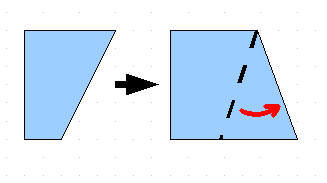
My latest posts can be found here: Previous blog posts:
Additionally, some earlier writings: |
The Trapezium Conundrum - 2012/04/17
I've had to apologise. Unreservedly. I was guided by my intuition as a Ph.D. in Pure Maths, and by my 30 or so years of study, research, and subsequent work as an industrial mathematician. My training is in Pure Maths, my research was in Pure Maths, and then computing, and my work in industry has ranged widely over many disciplines. I believe I have a fair feel for what's going to be useful or fruitful, and I used that as the starting point for my replies. I wasn't necessarily right. Let me say at this point that teachers have an impossibly difficult task. They need to keep discipline, engage the uninterested and disinterested, encourage those who feel they will never understand, stretch those who find the current work easy, and prepare their students for exams that do not, in truth, test the skills and abilities that are of the most value. But I digress. Let me talk about definitions. Clear, precise, unambiguous and useful definitions are hard to come by in the real world. Every time someone comes up with a definition for something, someone will find a counter-example, or something that you feel ought to be covered or included, but isn't. Sometimes even finding a definition at all can be hard. What's the difference between a jar and a bottle? What's the difference between a leaflet, pamphlet and booklet? These distinctions can be hard to pin down. But in maths we have the luxury of creating definitions that we want, and then chasing down the consequences. If the definition doesn't produce what we want, we can change it. But many of the definitions we use have gone through the fire of "usefulness." These are definitions that someone created, they and others adapted, modified, changed, warped, or otherwise "fixed" until they were at their height of value. It's important to remember that they are in some sense still arbitrary, but when they have been used for decades, or centuries, and people still use them, you have to feel that they are, in some sense, "right." And so it is with simple things like "even" and "odd." These definitions have emerged over time and have been kept because they correspond to useful ideas. The definition that mathematicians use is that a number is "even" if it is twice some whole number. So ...
So now we ask - "Is zero even?" Well, zero is twice something else - it's twice 0. But is 0 a whole number? And if you say "Yes," why do you say that? Well, we like the idea that whenever we add two whole numbers, the result is a whole number. We like the idea that whenever we subtract two whole numbers, the result is always a whole number. We can choose (if we like) to say that zero is not in fact a whole number, but then we have to include all sorts of exceptions.
Of course, sometimes it turns out to be even more awkward to make "the other choice" (whatever that may be) but in the case of "numberhood" is certainly makes things easier to allow zero into the club and call it a whole number. So if zero is a number, and a whole number at that, then it must (by our definition) be an even number. After all, it is twice a whole number, and that's our definition. Now, some people find this unsettling because they've never really thought of zero as even or odd. Some people's intuition says that zero isn't even. And that's fair enough, but it makes life more difficult in the long run. It turns out to be much easier to declare that zero is indeed a whole number, and that it does satisfy the definition for evenness, and so it is an even whole number. Now, much debate can be expended before we even have something that approximates a definition. Many circles have been gone round before the result is achieved:
So now that I've set the scene, I return to the longer discussion that I had on Twitter concerning the definitions of Trapezoid and Trapezium. This is confused by the fact (according to the Wikipedia article) that the meanings of the terms are reversed between British and American English. Great. OK, I will here use the British English versions.
For these reasons it would seem simpler and easier to require that a Trapezium has at least one pair of parallel sides, and allow that a parallelogram is a special case of the Trapezium. The usage of the definitions then turns out to be a lot simpler, and does not require the constant exceptions to be made explicitly. Similarly one can allow that a square is a special case of a rectangle, Trapezium, and kite (whatever that is!) For the mathematician this is largely a non-issue. Definitions are intended to be useful and convenient, and when there is a danger of misunderstanding, they are clarified. Modified definitions are used all the time, with care being exercised on both sides to avoid (or at least reduce) miscommunication. But for teachers this is a nightmare. Most of their students won't become mathematicians and demand rigid, definite and definitive definitions. They won't like the idea that it doesn't really matter, and no doubt the school curriculum will specify that the students must know these things and be able to regurgitate them unthinkingly on demand. For you, sadly, I offer no absolute answers, but I hope I've given an insight into how at least one mathematician thinks about these things.
References:
Send us a comment ...
|

 Suggest a change ( <--
What does this mean?) /
Send me email
Suggest a change ( <--
What does this mean?) /
Send me email